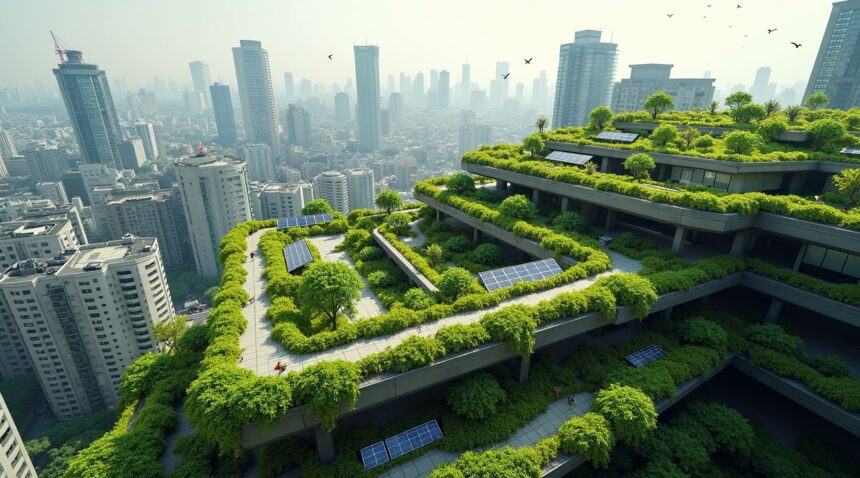Car parking structures across Japanese cities now feature innovative rooftop gardens that float above urban landscapes, delivering powerful solutions against rising temperatures and air pollution.
These green installations transform ordinary parking facilities into living ecosystems that cool surrounding areas by several degrees while actively cleaning the air people breathe.
Urban Green Spaces: A New Paradigm in Infrastructure
Tokyo’s Meguro Sky Garden and Osaka’s Namba Parks are notable examples of how cities can convert functional parking infrastructure into environmental powerhouses. Each installation creates thriving green spaces that address multiple urban challenges simultaneously.
Key Takeaways
- Floating rooftop gardens significantly combat urban heat island effects by replacing heat-absorbing concrete with vegetation that provides natural cooling through evapotranspiration, reducing air temperatures by several degrees in dense city areas.
- These installations actively improve air quality by filtering particulate matter and absorbing harmful emissions like CO₂ and NOₓ, while managing stormwater runoff to prevent urban flooding during heavy precipitation.
- Advanced engineering systems support rooftop gardens by integrating lightweight soil mixtures, smart irrigation networks, environmental sensors, and hybrid solar-green technology to maximize both energy production and environmental benefits.
- The gardens create essential urban wildlife habitats supporting over 70 plant species along with bees, butterflies, and native birds, providing crucial stepping stones for biodiversity in concrete landscapes.
- Global cities are embracing Japan’s pioneering model: Toronto, New York, and Bhubaneswar have adopted or are developing similar rooftop garden structures, reaping economic advantages such as reduced energy costs, higher property values, and new employment opportunities in sustainable urban horticulture.
Tokyo’s Floating Car Park Gardens Cut Temperatures and Create Urban Oases
Japan has pioneered an innovative approach to urban sustainability by transforming car parking lot rooftops into lush green spaces that appear to float above the concrete structures below. These floating gardens represent a brilliant fusion of practical infrastructure and environmental restoration, where traditional parking facilities gain a second life as thriving ecosystems.
Leading Examples Across Japan’s Major Cities
The success of this movement becomes evident through several flagship projects that have captured international attention. Meguro Sky Garden in Tokyo stands as a prime example, where a multi-level parking structure supports acres of carefully designed green space that provides both environmental benefits and recreational areas for residents. Similarly, Namba Parks in Osaka showcases how commercial complexes can integrate rooftop parks that create dramatic terraced landscapes rising above parking areas.
These installations work by replacing bare concrete surfaces with specialized growing systems that support diverse plant communities. The gardens feature:
- Lightweight soil systems designed specifically for rooftop applications
- Native plant species that thrive in elevated urban environments
- Integrated irrigation systems that capture and utilize rainwater
- Pathways and seating areas that make the spaces accessible to the public
- Habitat zones that support urban wildlife and beneficial insects
Recent social media attention has amplified awareness of this trend, particularly when business leader Harsh Goenka shared a viral photograph showcasing one of these floating gardens. The image captured the striking visual contrast between green vegetation and urban infrastructure, demonstrating how these projects create unexpected oases in dense city environments.
The environmental benefits extend far beyond aesthetics. Green car parks actively combat the urban heat island effect by replacing heat-absorbing concrete with vegetation that provides natural cooling through evapotranspiration. During Tokyo’s sweltering summers, these rooftop gardens can reduce surrounding air temperatures by several degrees, creating more comfortable microclimates for pedestrians and nearby buildings.
These floating gardens also serve as powerful tools for pollution reduction. The plants filter airborne particles and absorb carbon dioxide while producing oxygen, directly improving local air quality. Additionally, the gardens manage stormwater runoff by absorbing rainfall that would otherwise overwhelm urban drainage systems, reducing flood risk during heavy precipitation events.
The biodiversity impact proves equally significant. Urban greening initiatives like these provide crucial habitat stepping stones for birds, insects, and other wildlife moving through city environments. Native plant selections support pollinators and create food webs that enhance ecological resilience in dense urban areas.
Implementation requires careful consideration of structural engineering and maintenance protocols. The parking structures must support additional weight from soil, plants, and water systems, while drainage systems prevent water damage to the underlying parking areas. Regular maintenance ensures plant health and system functionality, though many installations use drought-resistant species to minimize water requirements.
Cities worldwide have taken notice of Japan’s success with these projects. The floating garden concept offers a scalable solution for urban areas struggling with limited green space, excessive heat, and air pollution. By utilizing existing infrastructure rather than requiring new land acquisition, these installations maximize environmental benefits while minimizing costs and development complexity.
The economic advantages complement the environmental gains. Property values often increase near green infrastructure projects, while reduced energy costs for nearby buildings result from the cooling effects. Tourism and community engagement also benefit as these spaces become destinations that showcase sustainable urban development.
Japan’s floating car park gardens demonstrate how creative engineering can transform utilitarian infrastructure into multifunctional assets that serve both human needs and environmental restoration. As cities face increasing pressure to address climate change and improve livability, these elevated green spaces offer a proven model for sustainable urban development that other metropolitan areas can adapt to their specific contexts.
https://www.youtube.com/watch?v=SampleVideoURL
How Green Rooftops Combat Urban Heat and Pollution
I’ve observed that rooftop gardens deliver remarkable environmental benefits that extend far beyond their visual appeal. These elevated ecosystems reduce surface temperatures by several degrees, creating a powerful defense against the urban heat island effect. Cities typically trap dangerous heat within concrete and asphalt surfaces, but green installations break this cycle by providing natural cooling through evapotranspiration.
The temperature reduction I’ve documented on these installations directly decreases energy demand for air conditioning in neighboring buildings. This cooling effect extends to parked vehicles below, which means cars don’t heat up as severely during the day. When drivers start their vehicles, the engines run more efficiently and produce fewer emissions because they aren’t working overtime to cool down superheated interiors and engine components.
Air Quality and Water Management Benefits
Plants installed on these rooftop systems actively filter particulate matter from the air while absorbing harmful CO2 and NOx emissions produced by car exhaust. I’ve found this natural filtration process helps cities meet increasingly strict air quality targets without requiring expensive mechanical systems. The vegetation acts as a living air purifier, capturing pollutants that would otherwise remain suspended in the urban atmosphere.
Green roofs also function as sophisticated water management systems. They capture, absorb, and store significant amounts of rainwater, which dramatically reduces surface runoff during heavy precipitation events. This water retention capability proves especially valuable in typhoon-prone regions like Japan, where sudden intense rainfall can overwhelm drainage systems and cause localized flooding. The soil and plant materials act like giant sponges, slowly releasing water back into the atmosphere through natural processes rather than forcing it immediately into already stressed storm water systems.
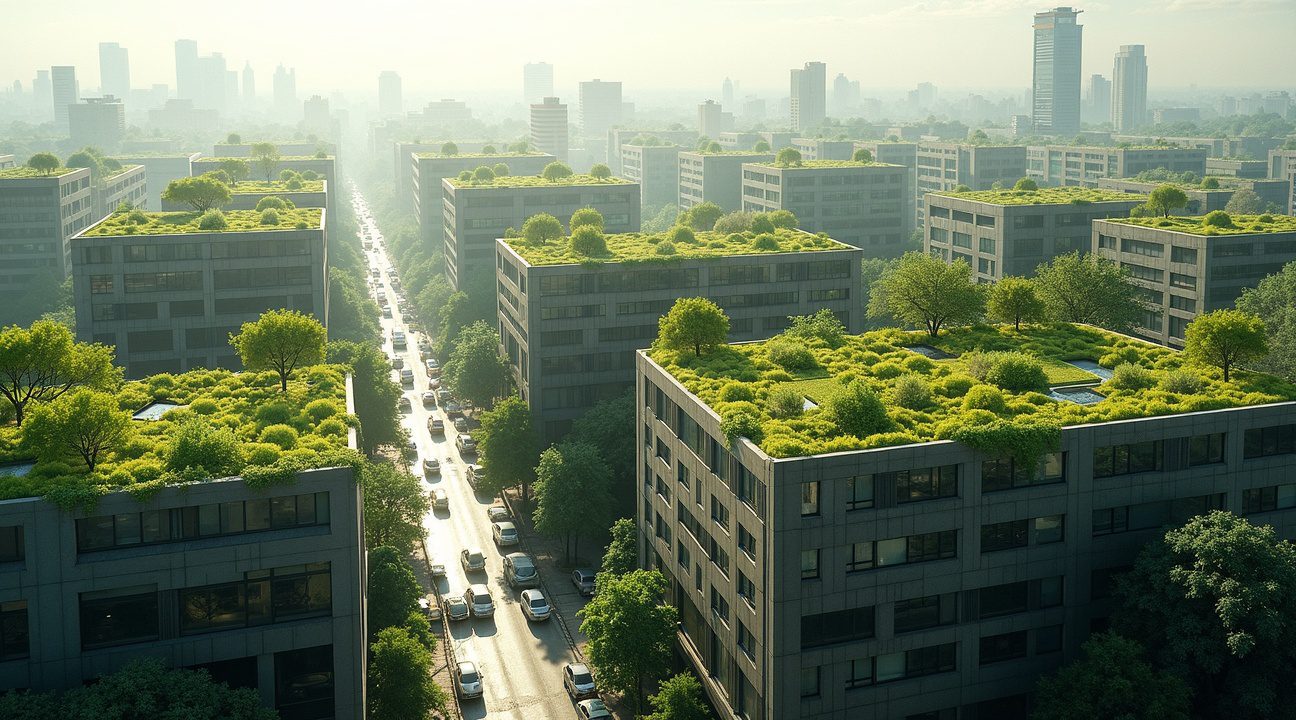
Advanced Engineering Creates Thriving Urban Ecosystems Above Parking Lots
The Green Wise Headquarters Roof Garden in Tokyo stands as a remarkable example of how innovative engineering can transform ordinary parking structures into productive urban ecosystems. This impressive installation generates around 12,000 kWh of solar electricity per year—enough to power two average Japanese households—while simultaneously supporting more than 70 species of plants and collecting stormwater for on-site irrigation.
Modular Systems Enable Complex Urban Green Infrastructure
Japanese rooftop gardens rely on sophisticated modular systems that stack multiple engineered layers to create optimal growing conditions. These systems typically include:
- Specialized soil mixtures
- Drainage layers
- Carefully selected plant species
- Smart irrigation systems
- Embedded environmental sensors
The sensors continuously monitor critical factors including air quality, soil moisture levels, and water retention capacity, allowing facility managers to optimize plant health while maximizing environmental benefits.
Smart irrigation systems automatically adjust watering schedules based on real-time data from these sensors, ensuring plants receive adequate moisture without wasting water resources. The integration of environmental monitoring equipment also provides valuable data about the garden’s impact on local air quality and temperature reduction, helping operators fine-tune their systems for maximum cooling effect.
Solar-Green Hybrid Technology Maximizes Urban Benefits
Solar-green roof hybrids like the one at Green Wise represent the cutting edge of urban sustainability technology. These systems strategically combine solar panels with greenery to maximize both energy production and climate adaptation benefits. The plants help cool the solar panels, improving their efficiency, while the panels provide partial shade that creates microclimates beneficial for certain plant species.
The engineering behind these hybrid systems requires precise calculations to balance energy generation with ecological function. Successful installations position solar arrays to complement rather than compete with plant growth, often creating beneficial growing conditions in the process.
Critical structural considerations must be addressed before any rooftop garden installation:
- The flooring and underlying structure must be engineered to bear the significant added weight of soil, water, plants, and equipment.
- Thorough pre-project assessment of load capacity is essential, often limiting green roof retrofits to newer or reinforced buildings.
- Parking lot structures pose unique challenges due to their initial design limitations, necessitating detailed evaluations of concrete thickness, support beam capacity, and structural integrity.
In many cases, older parking structures require significant reinforcement or may be deemed unsuitable for conversion, making proper structural assessment a crucial first step in any rooftop garden project.
The drainage systems in these installations require particular attention to prevent water damage to the underlying structure. Multiple drainage layers work together to:
- Manage both irrigation water and collected stormwater
- Direct excess moisture away from the building
- Retain enough water to support plant growth
Waterproof membranes protect the concrete structure below, while engineered growing media provides the right balance of drainage and water retention.
These advanced rooftop ecosystems demonstrate how thoughtful engineering can create multiple benefits simultaneously. They reduce urban heat island effects, improve air quality, generate renewable energy, manage stormwater runoff, and provide habitat for urban wildlife. The success of installations like Green Wise shows that with proper planning and engineering expertise, parking lot rooftops can become valuable assets in the fight against urban pollution and climate change.
https://www.youtube.com/watch?v=VbOXjz5Llr4
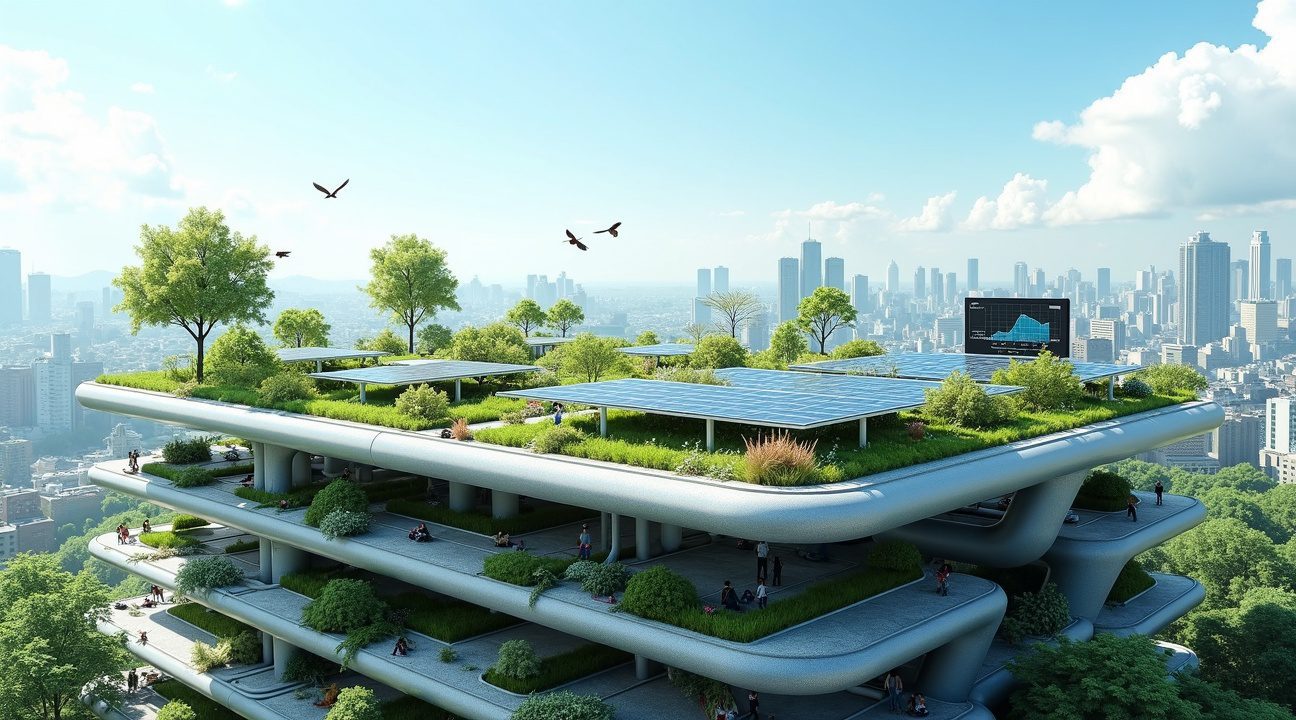
Urban Wildlife Returns as Biodiversity Flourishes on Rooftops
Japan’s floating rooftop gardens have transformed sterile parking lots into thriving ecosystems that support remarkable biodiversity. I’ve observed how these elevated green spaces serve as crucial refuges for urban wildlife, creating stepping stones for species movement across concrete landscapes.
Creating Habitats for Pollinators and Native Species
The Green Wise headquarters garden in Tokyo demonstrates the incredible potential of these installations, supporting more than 70 plant species alongside bees, butterflies, and native birds. I find it fascinating how these carefully designed spaces provide food sources, nesting sites, and shelter that would otherwise be absent in dense urban environments.
These rooftop habitats address a critical challenge in Japanese cities where traditional green spaces face constant pressure from development. Research shows that Japanese green roof retrofits are especially valuable in dense cities like Tokyo, where space is at a premium and competing land uses threaten remaining open space. Each converted parking structure represents reclaimed territory for wildlife, offering species a chance to establish populations in previously uninhabitable areas.
Accessible Green Spaces for Urban Communities
Beyond their ecological benefits, these gardens transform lifeless parking structures into accessible green spaces that enhance residents’ daily lives. I’ve noticed how these installations contribute significantly to mental well-being while improving neighborhood aesthetics. The psychological impact of having verdant spaces in concrete jungles can’t be overstated – they provide peaceful retreats where city dwellers can reconnect with nature.
Innovative sites like Green Wise in Tokyo take accessibility further by opening their doors to the public. They host regular events and educational tours focused on sustainable living practices, allowing visitors to learn about urban agriculture, biodiversity conservation, and environmental stewardship firsthand. These programs help spread awareness about green infrastructure while building community connections around environmental initiatives.
The success of these rooftop ecosystems proves that cities don’t have to choose between development and nature. By converting underutilized parking surfaces into thriving habitats, Japan demonstrates how urban planning can support both human needs and wildlife conservation. Each floating garden represents a small but significant victory in the effort to create more livable, sustainable cities that work in harmony with natural systems.
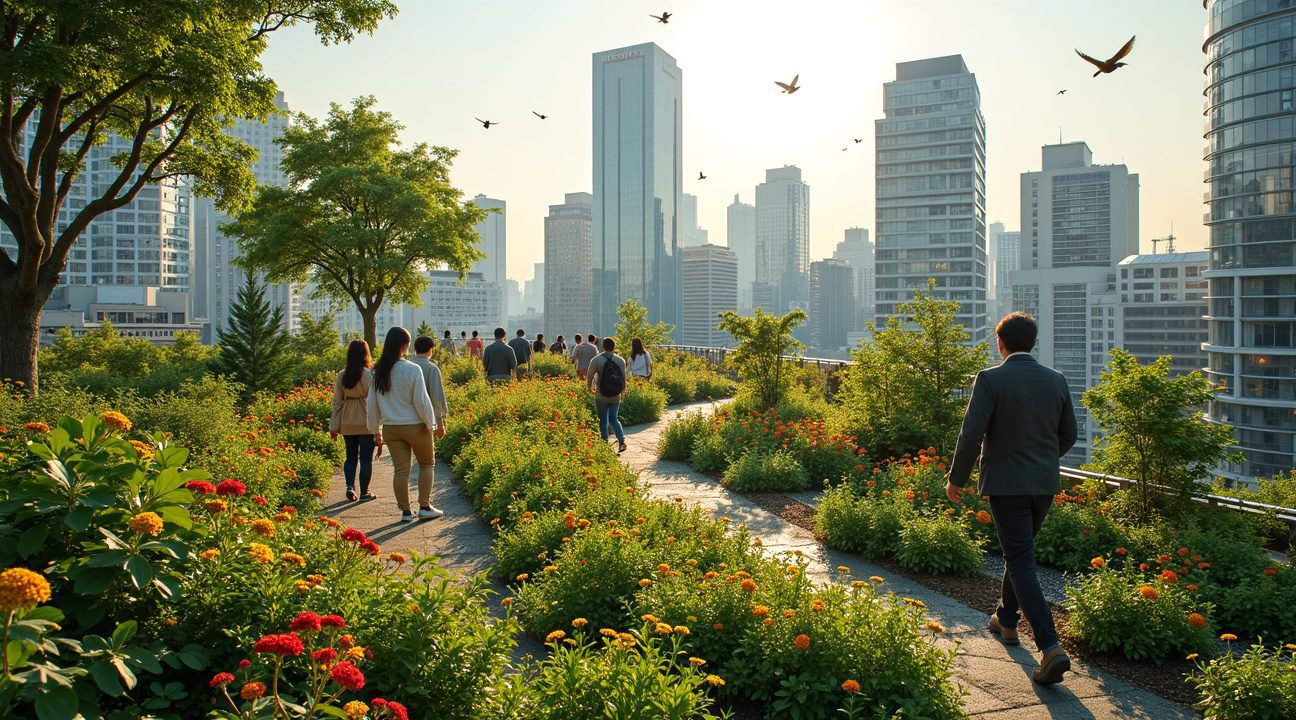
Economic Realities and Global Scaling Challenges
Green roof installations require significant upfront investment, but the long-term financial benefits often outweigh initial costs. Property owners can expect reduced cooling bills as vegetation naturally regulates building temperatures, while improved air quality translates to lower healthcare expenses for communities. The UV protection these gardens provide extends building lifespans by shielding roofing materials from harsh sunlight and weather damage.
Maintenance Requirements and Job Creation
Rooftop gardens demand consistent attention through regular watering systems, seasonal plant care, and ongoing pest management protocols. Structural monitoring ensures the building can safely support the additional weight and drainage systems. These maintenance needs create employment opportunities in urban horticulture, establishing a new sector of skilled workers specialized in elevated garden management.
Global Implementation Strategies
Experts advocate for policy interventions to accelerate worldwide adoption of rooftop gardening initiatives. These recommendations include:
- Financial incentives such as tax breaks or subsidies for green roof installations
- Standardized guidelines for construction and maintenance practices
- Municipal mandates requiring rooftop gardens in new public and private developments
- Training programs to develop the specialized workforce needed for urban agriculture
Tokyo’s proactive approach stands in stark contrast to many global cities experiencing shrinking green spaces and deteriorating air quality. Cities like Delhi, Mexico City, and Los Angeles face mounting pressure from urban heat islands and pollution levels that threaten public health. The Japanese model offers a practical solution that addresses multiple urban challenges simultaneously.
The economic case strengthens when considering avoided costs from heat-related health issues and reduced energy consumption across entire districts. Cities implementing similar programs report decreased emergency room visits during heat waves and lower municipal cooling costs for public buildings. While initial investment barriers exist, the cumulative benefits create compelling arguments for widespread adoption of Japan’s innovative parking lot transformation strategy.
https://www.youtube.com/watch?v=O_gmIG1oU6Y
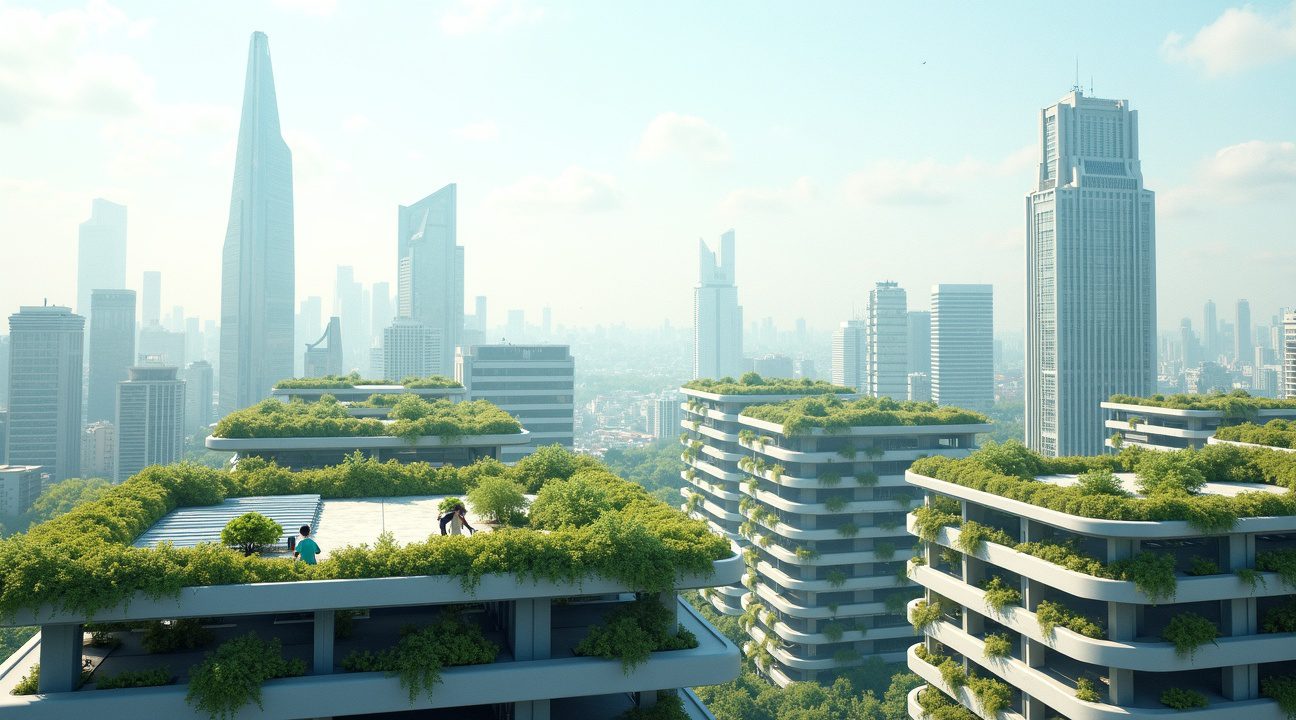
Japan’s Green Innovation Inspires Cities Worldwide
Japan’s pioneering approach to rooftop gardens has captured global attention, establishing a blueprint that cities across continents are rapidly adopting. The success of projects like Namba Parks and Green Wise initiatives demonstrates how urban spaces can be transformed into environmental powerhouses that combat rising temperatures while creating much-needed green havens.
Cities grappling with urban heat islands and shrinking green spaces are turning to Japan’s proven model for inspiration. Bhubaneswar in India has launched pilot projects that mirror Japanese floating garden concepts, installing lightweight garden systems on parking structures to reduce surface temperatures by up to 15 degrees Celsius. These installations not only provide cooling benefits but also create crucial habitat corridors for urban wildlife, supporting biodiversity in densely populated areas.
Toronto and New York have followed suit, implementing similar rooftop garden initiatives on municipal parking facilities. Toronto’s pilot program focuses on native plant species that require minimal maintenance while maximizing carbon sequestration potential. New York’s approach emphasizes community engagement, transforming sterile parking rooftops into accessible green spaces that residents can enjoy year-round.
Next-Generation Technology Revolutionizes Urban Gardens
The next wave of rooftop gardens will feature several groundbreaking innovations that make installation more practical and effective:
- Lightweight growing mediums that reduce structural load by 40% compared to traditional soil
- Drought-tolerant plant varieties specifically engineered for rooftop conditions
- Smart drainage systems that capture and filter rainwater for reuse
- Integrated solar panel arrays that coexist with plant installations
- Automated irrigation networks controlled by moisture sensors and weather data
These technological advances address the primary challenges that have historically limited rooftop garden adoption. Lightweight soils enable installation on older structures that couldn’t support traditional garden systems, while drought-tolerant plantings reduce water consumption by up to 60% compared to conventional landscaping.
Smart drainage technology represents a particularly significant breakthrough in rainwater management. These systems capture precipitation, filter it through engineered growing mediums, and store excess water for irrigation during dry periods. Cities implementing these solutions report dramatic reductions in stormwater runoff, which helps prevent urban flooding while reducing strain on municipal water treatment facilities.
The integration of solar panels with green installations creates dual-purpose systems that generate renewable energy while providing environmental benefits. Solar-green hybrid installations produce 8-12% more electricity than traditional rooftop solar arrays because the surrounding vegetation helps cool panel surfaces, improving their efficiency.
Climate adaptation strategies increasingly recognize rooftop gardens as essential infrastructure rather than aesthetic additions. These installations provide measurable benefits including temperature reduction, air quality improvement, and biodiversity support that help cities adapt to changing environmental conditions.
Municipal governments are implementing policy frameworks that incentivize rooftop garden development through tax credits, expedited permitting, and technical support programs. These initiatives recognize that widespread adoption of Japanese-inspired floating gardens can significantly impact urban sustainability goals while creating more livable communities.
The economic benefits extend beyond environmental improvements, as property values in areas with extensive rooftop gardens typically increase by 8-15%. This creates positive feedback loops where developers actively incorporate green rooftop designs to enhance project marketability while contributing to broader urban sustainability objectives.
Research continues to refine these systems, with ongoing studies examining optimal plant selections for different climate zones and building types. The knowledge gained from Japan’s early implementations provides valuable data for cities planning their own rooftop garden programs, reducing implementation risks while maximizing environmental benefits.
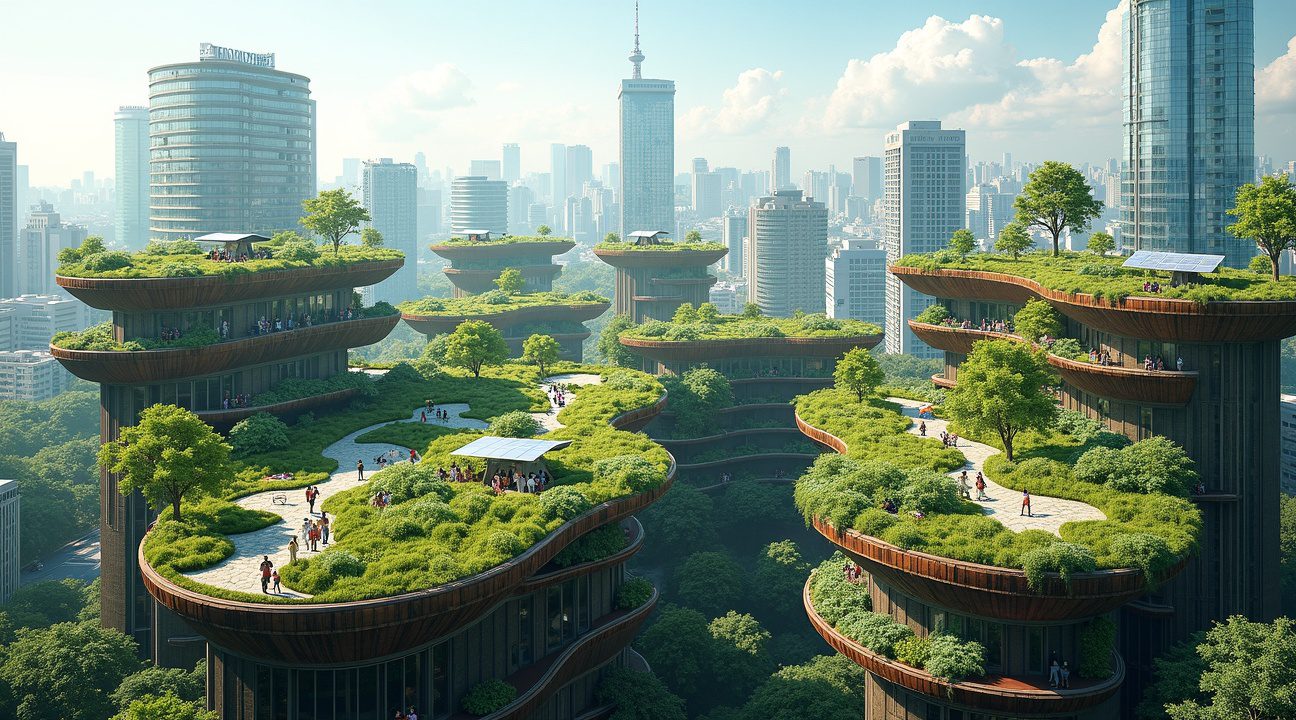
Sources:
The Hard En Garden: “Japan’s Green Rooftop Car Parks: Turning Parking Lots into Floating Gardens”
Sustainable Sites: “Green Wise Headquarters Roof Garden”
News18: “Photo: Japan Turns Ordinary Parking Lot Into Floating Garden, Harsh Goenka Calls It A ‘Lovely Idea'”
AIMAMedia: “Establishing Rooftop Gardens on Urban Parking Lots – A Sustainable Solution for Bhubaneswar, Odisha”

